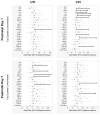Systemic inflammation in the extremely low gestational age newborn following maternal genitourinary infections
- PMID: 25164433
- PMCID: PMC4293273
- DOI: 10.1111/aji.12313
Systemic inflammation in the extremely low gestational age newborn following maternal genitourinary infections
Abstract
Problem: Gestational genitourinary infections are associated with lifelong disabilities, but it is unknown if neonatal inflammation is involved.
Method: Mothers of 914 infants born before 28th gestation week reported cervical/vaginal infection (CVI), and/or urine/bladder/kidney infection (UTI), or neither. Inflammation proteins measured in baby's blood on postnatal days 1, 7, and 14 were considered elevated if in the top quartile for gestational age. Logistic regression models adjusting for potential confounders assessed odds ratios.
Results: Compared to mothers with neither UTI/CVI, those with CVI were more likely to have infants with elevated CRP, SAA, MPO, IL-1β, IL-6, IL-6R, TNF-α, RANTES, ICAM-3, E-selectin, and VEGF-R2 on day 1; those with UTI were more likely to have infants with elevated MPO, IL-6R, TNF-R1, TNF-R2, and RANTES on day 7. Placental anaerobes and genital mycoplasma were more common in pregnancies with CVI.
Conclusion: Gestational UTI/CVI should be targeted for preventing systemic inflammation in the very preterm newborn.
Keywords: Acute phase proteins; cervicitis; cytokines; placental microbiome; preterm birth; vaginitis.
© 2014 John Wiley & Sons A/S. Published by John Wiley & Sons Ltd.
Conflict of interest statement
None of the authors have commercial or other associations that may pose a conflict of interest with the content of this article.
Figures

References
-
- Collier CH, Risnes K, Norwitz ER, Bracken MB, Illuzzi JL. Maternal infection in pregnancy and risk of asthma in offspring. Maternal and child health journal. 2013;17(10):1940–1950. - PubMed
-
- Camp BW, Broman SH, Nichols PL, Leff M. Maternal and neonatal risk factors for mental retardation: defining the ‘at-risk’ child. Early Hum Dev. 1998;50(2):159–173. - PubMed
Publication types
MeSH terms
Substances
Grants and funding
LinkOut - more resources
Full Text Sources
Other Literature Sources
Research Materials
Miscellaneous

